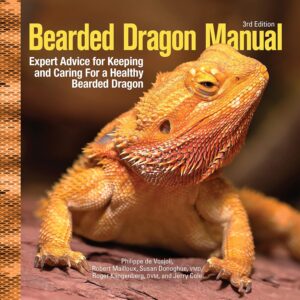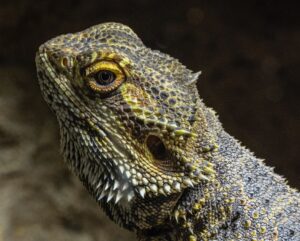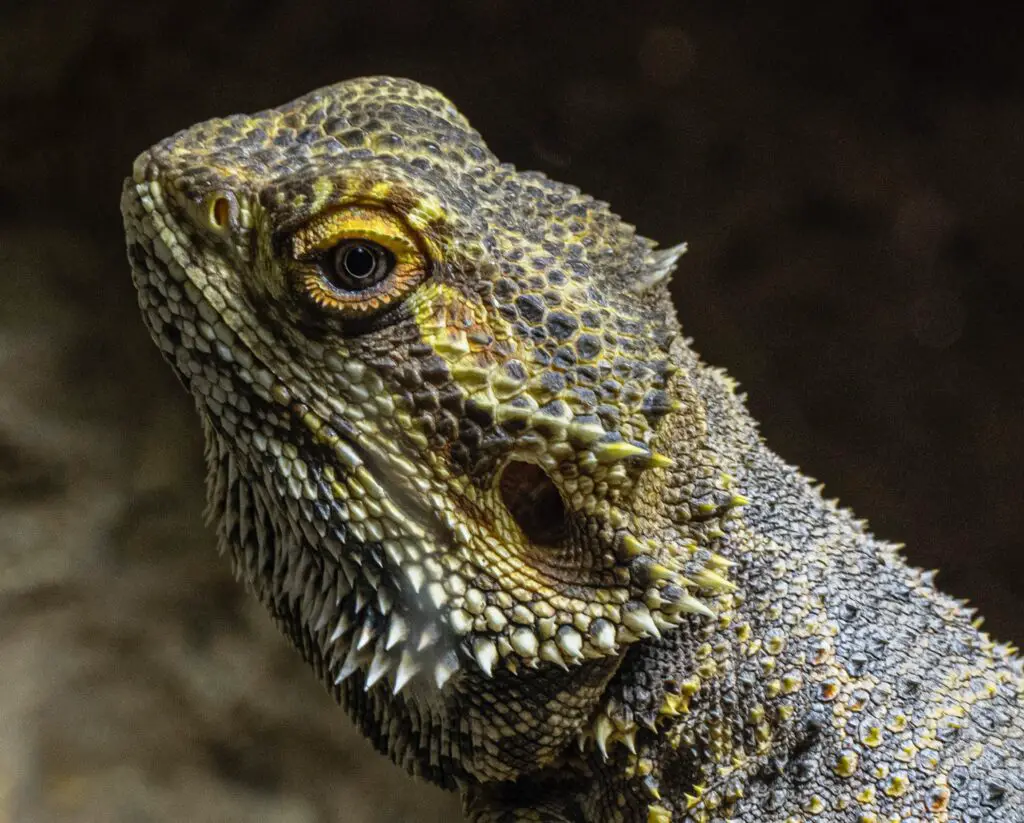How smart are bearded dragons
How smart are bearded dragons: Bearded dragons, scientifically known as Pogona, are fascinating reptiles native to Australia. These majestic creatures have captivated the hearts of reptile enthusiasts and pet owners worldwide, garnering immense popularity due to their docile nature and unique appearance.
Bearded dragons derive their name from the beard-like spiny scales under their jaws that they puff up as a display of dominance or defense. With their vibrant colors and mild temperament, they have become beloved pets for many.
Definition of Bearded Dragons
Bearded dragons belong to the family Agamidae and are characterized by their stout bodies, triangular heads, and long tails. They come in various species, including Pogona vitticeps (Inland or Central Bearded Dragon), Pogona barbata (Eastern Bearded Dragon), and Pogona henrylawsoni (Rankin’s Dragon). These reptiles can reach an average length of 18-24 inches when fully grown.
Overview of Their Intelligence
 The intelligence of bearded dragons is a topic that has piqued the curiosity of researchers and reptile enthusiasts alike. While they may not exhibit intelligence in the same way mammals do, these remarkable creatures possess unique cognitive abilities that make them truly captivating.
The intelligence of bearded dragons is a topic that has piqued the curiosity of researchers and reptile enthusiasts alike. While they may not exhibit intelligence in the same way mammals do, these remarkable creatures possess unique cognitive abilities that make them truly captivating.
When it comes to general intelligence, bearded dragons showcase remarkable cognitive abilities and problem-solving skills. They have demonstrated an impressive capacity for learning and remembering information.
Through experiments involving food rewards and environmental enrichment, researchers have found that bearded dragons can quickly associate specific cues with rewards or punishments. In addition to associative learning, bearded dragons display problem-solving capabilities through trial-and-error approaches.
Whether it’s figuring out how to escape from enclosures or accessing hard-to-reach food sources, these reptiles have shown a remarkable aptitude for spatial awareness and navigation. They can adapt their behavior based on the challenges presented to them, demonstrating an impressive level of problem-solving intelligence.
Furthermore, bearded dragons possess social intelligence, which is evident in their communication and social behavior. Through visual signals such as head bobbing, posture changes, and color displays, they can effectively convey messages to conspecifics (members of the same species).
These interactions are crucial for establishing dominance hierarchies and maintaining social cohesion within their communities. While bearded dragons may not possess intellect in the same manner as humans or some mammals do, their unique cognitive abilities and problem-solving skills make them highly intriguing creatures.
From their capacity for associative learning to their adeptness at social communication, these reptiles exhibit an intelligence that continues to captivate researchers and enthusiasts alike. In the following sections of this article, we will delve deeper into various aspects of bearded dragon intelligence to fully appreciate the remarkable capabilities of these reptiles.
General Intelligence of Bearded Dragons
Cognitive abilities and problem-solving skills
Bearded dragons exhibit remarkable cognitive abilities and problem-solving skills, which are indicative of their intelligence. These reptiles possess a keen sense of awareness and are known to actively engage with their environment.
One notable aspect of their cognitive abilities is their remarkable capacity to learn and remember information. Studies have shown that bearded dragons can quickly grasp new concepts, demonstrating a high level of intellectual flexibility.
Ability to learn and remember
Bearded dragons have an impressive ability to learn and retain information, making them highly adaptable creatures. They can swiftly associate certain stimuli with particular outcomes, allowing them to learn from past experiences.
For instance, bearded dragons can associate the presence of food with specific cues such as the sound of a container opening or the sight of a feeder approaching. This associative learning helps them remember where they found food sources in the past, enabling efficient foraging behaviors.
Problem-solving through trial and error
Another aspect that showcases the intelligence of bearded dragons is their problem-solving skills. When faced with challenges or obstacles, these reptiles exhibit perseverance and creativity in finding solutions.
Through trial and error, they explore different approaches until they achieve a desired outcome. For example, in laboratory experiments where bearded dragons were presented with puzzle boxes containing hidden rewards, they demonstrated an ability to assess the situation, analyze the box’s mechanics, and eventually figure out how to open it using their physical dexterity.
Spatial awareness and navigation skills
 Bearded dragons also possess exceptional spatial awareness and navigation skills. Studies have revealed that they can form mental maps of their surroundings based on visual cues such as landmarks or distinctive environmental features like rocks or trees. This innate sense allows them to navigate efficiently within their habitats while searching for resources or establishing territories.
Bearded dragons also possess exceptional spatial awareness and navigation skills. Studies have revealed that they can form mental maps of their surroundings based on visual cues such as landmarks or distinctive environmental features like rocks or trees. This innate sense allows them to navigate efficiently within their habitats while searching for resources or establishing territories.
Bearded dragons can also remember the locations of their shelters, basking spots, and food sources, showcasing their spatial memory capabilities. Bearded dragons exhibit not only general intelligence but also a range of specific cognitive abilities that highlight their remarkable intellect.
Their capacity to learn and remember information, problem-solve through trial and error, as well as navigate their environments with spatial awareness showcase their adaptability and resourcefulness. The combination of these skills contributes to the overall intelligence observed in bearded dragons, making them fascinating creatures worthy of admiration.
Social Intelligence of Bearded Dragons
Communication and Social Behavior
Bearded dragons exhibit a remarkable level of social intelligence, which is evident in their communication and social behavior. Through various visual signals and body language, they can convey their intentions and establish social hierarchies. When feeling threatened or agitated, bearded dragons may puff up their throat to display an intimidating bearded appearance, hence their name.
This visual signal serves as a warning to potential rivals or predators. Additionally, they may flatten their bodies against the ground to appear larger or raise themselves on their hind legs as a sign of dominance.
Visual Signals and Body Language
The ability of bearded dragons to communicate through visual signals and body language is truly fascinating. They use a myriad of gestures and postures to convey messages within their social group.
For instance, when two bearded dragons meet for the first time or during territorial disputes, they engage in head-bobbing displays. This behavior involves rhythmic up-and-down movements of the head accompanied by arm waving.
The speed and intensity of head-bobbing can indicate either aggression or submission. In addition to head-bobbing, tail movements play a vital role in communication among bearded dragons.
A raised tail signifies aggression, while a lowered tail indicates submission or appeasement toward dominant individuals. By observing these intricate visual cues, both members within the species are able to establish boundaries and avoid unnecessary conflicts.
Recognition of Conspecifics (Members of the Same Species)
 Bearded dragons possess an innate ability to recognize conspecifics (members of the same species), allowing them to form social bonds with individuals from their own kind. This recognition is primarily based on visual cues such as size, coloration patterns, markings, and overall body structure.
Bearded dragons possess an innate ability to recognize conspecifics (members of the same species), allowing them to form social bonds with individuals from their own kind. This recognition is primarily based on visual cues such as size, coloration patterns, markings, and overall body structure.
Studies have shown that they can distinguish between familiar individuals and strangers, demonstrating their social intelligence. Furthermore, bearded dragons exhibit a phenomenon known as kin recognition.
This means that they can recognize and favorably respond to individuals they are genetically related to. This recognition aids in the formation of social groups within their natural habitats and can promote cooperation among related individuals.
Understanding Dominance Hierarchy Like many other social animals, bearded dragons establish dominance hierarchies within their groups.
The dominance hierarchy determines the order in which individuals interact with each other and access resources such as food, shelter, and mates. Through various behavioral displays, including head-bobbing, arm waving, throat puffing, and tail movements, bearded dragons communicate their social status.
Dominant individuals typically have priority access to resources and exert control over subordinate members through aggressive displays or territorial behavior. Subordinate individuals often show submissive behaviors like head lowering or backing away when faced with dominant conspecifics.
Understanding this hierarchical structure is crucial for maintaining social balance and minimizing conflicts within a group of bearded dragons. Bearded dragons possess an impressive level of social intelligence that manifests in their communication techniques, recognition of conspecifics, and understanding of dominance hierarchies.
Their ability to use visual signals and body language allows them to convey intentions while minimizing physical confrontation. By recognizing familiar individuals from their own species based on visual cues, they form cohesive social groups that promote cooperation among kin.
Moreover, the establishment of dominance hierarchies ensures efficient resource allocation within a group of bearded dragons. Overall, these aspects highlight the intricate social intelligence displayed by these fascinating reptiles.
Learning Abilities in Bearded Dragons
Associative Learning
Associative learning refers to the ability of an organism to form connections between different stimuli or events. Bearded dragons have demonstrated impressive associative learning abilities, particularly when it comes to food rewards.
In laboratory experiments, researchers have used classical conditioning techniques to train bearded dragons to associate specific stimuli with receiving food. For example, a particular light or sound cue is paired with the presentation of food repeatedly until the bearded dragon begins to anticipate the reward when exposed to that specific cue.
Classical Conditioning Experiments with Food Rewards
Classical conditioning experiments involving bearded dragons have showcased their remarkable ability to learn and make associations between environmental cues and positive outcomes. In one such study, researchers trained bearded dragons by presenting them with a visual cue, such as a colored light bulb, prior to providing them with a tasty treat.
Over time, the bearded dragons learned to associate the presentation of that specific visual cue with receiving food. As a result, they began exhibiting anticipatory behaviors in response to the cue alone.
This form of associative learning indicates that bearded dragons possess cognitive flexibility and can quickly make connections between seemingly unrelated events through experience and reinforcement. It suggests that they have some level of awareness and can modify their behavior based on past associations.
Pavlovian Response to Stimuli like Light or Sound Cues
Bearded dragons exhibit what is known as a Pavlovian response, named after the famous Russian physiologist Ivan Pavlov who studied conditional reflexes in dogs. Similar principles apply here: when exposed repeatedly to certain stimuli paired with an outcome (such as food), bearded dragons begin associating those stimuli with positive experiences and develop conditioned responses. In experiments exploring Pavlovian response in bearded dragons, scientists often use external cues like lights or sounds to trigger specific behaviors.
For instance, by consistently pairing the sound of a bell with a food reward, bearded dragons can learn to associate the bell sound with the anticipation of food, leading them to exhibit behaviors such as increased alertness and movement. These experiments demonstrate that bearded dragons possess the capacity for learning through stimulus-response associations and can adapt their behavior based on environmental cues.
The ability of bearded dragons to form these associations through classical conditioning and Pavlovian response highlights their cognitive capabilities and showcases their capacity for learning and adapting to their environment. Further research in this area is shedding light on the complexity of their intelligence and expanding our understanding of these fascinating reptiles.
Memory Skills in Bearded Dragons
Short-term memory capabilities
Bearded dragons possess remarkable short-term memory capabilities, allowing them to remember information for a brief period. Research has shown that these reptiles can recall specific details or events for up to several minutes.
This ability is essential for their survival in the wild as it helps them navigate their environment and locate food sources efficiently. For example, a bearded dragon may remember the location of a hiding spot where it found prey recently, enabling it to revisit the same spot later when hungry.
Ability to recall information for a short period
The ability of bearded dragons to retain information for a short duration is demonstrated through various experiments and observations. Studies have indicated that these reptiles can recognize and remember familiar individuals, both conspecifics (members of the same species) and humans, even after relatively long intervals.
This suggests that they have the capability to retain memories beyond mere visual recognition and form associations with these individuals based on past interactions. Furthermore, bearded dragons have exhibited the capacity to learn from experience through trial and error, indicating an active memory process.
They are known to retain information about successful approaches or strategies when solving problems or encountering certain situations repeatedly. This adaptive trait allows them to modify their behavior based on past outcomes and make more informed decisions in similar circumstances.
Memory tests involving object recognition
In order to evaluate the memory skills of bearded dragons further, researchers have conducted experiments involving object recognition tests. These tests typically involve presenting the lizards with novel objects, which they are expected to remember upon subsequent encounters. The results indicate that bearded dragons possess an impressive ability to recognize objects they have previously encountered.
This form of visual memory demonstrates their capacity for learning through associations between objects and experiences or rewards encountered in their environment. For instance, if a particular object is consistently associated with a food reward during memory tests, the bearded dragon will likely display enhanced recognition and recall of the object in future encounters.
Bearded dragons exhibit notable memory skills, particularly in terms of short-term memory capabilities and object recognition. Their ability to recall information for short periods allows them to navigate their environment effectively and locate resources.
Additionally, their capacity to recognize familiar individuals and remember past experiences enables them to adapt their behavior based on previous encounters. These findings shed light on the cognitive abilities of these fascinating reptiles and provide insights into their remarkable intelligence.
Problem-Solving Skills in Bearded Dragons
Tool use experiments
Bearded dragons have demonstrated remarkable problem-solving skills when it comes to using tools for specific purposes. Researchers have conducted experiments to explore their ability to utilize objects as tools for obtaining food or escaping enclosures. These experiments involve presenting the bearded dragons with various objects and observing their behaviors and strategies.
Exploring the ability to use objects as tools for obtaining food or escaping enclosures
 In one study, captive bearded dragons were presented with a challenging scenario where they had to retrieve food from a hard-to-reach location. The researchers introduced a long stick into the enclosure and placed the food at the end of it. It was fascinating to observe how some bearded dragons quickly recognized that they could use the stick as an extension of their body to reach the desired treat.
In one study, captive bearded dragons were presented with a challenging scenario where they had to retrieve food from a hard-to-reach location. The researchers introduced a long stick into the enclosure and placed the food at the end of it. It was fascinating to observe how some bearded dragons quickly recognized that they could use the stick as an extension of their body to reach the desired treat.
They exhibited deliberate movements, pushing or pulling on the stick, demonstrating problem-solving abilities beyond simple trials and errors. Another experiment involved placing bearded dragons in an enclosure with a small opening that led to an adjacent space containing preferred hiding spots or rewards.
However, reaching this area required moving obstacles or manipulating certain objects strategically. Astonishingly, some individuals showcased ingenuity by using rocks or sticks found within their environment to create makeshift ramps or bridges, enabling them to access the desired area easily.
Examples from studies on captive bearded dragons
Several studies conducted on captive bearded dragons have provided compelling examples of their problem-solving capabilities. In one instance, researchers observed how these reptiles solved a puzzle box designed specifically for them.
The puzzle box had multiple compartments that needed sequential manipulation of levers and buttons before unlocking access to rewards like live insects or treats hidden inside. Furthermore, another study investigated how captive bearded dragons responded when confronted with transparent barriers obstructing their path towards prey items they could see.
Some individuals displayed innovative problem-solving strategies by using their snouts to push or nudge the barrier, attempting to create an opening to reach the desired prey. This demonstrated their ability to assess and adapt to novel situations, employing unconventional methods to overcome obstacles.
Overall, these experiments and studies provide substantial evidence of the problem-solving skills exhibited by bearded dragons. Their ability to utilize tools for obtaining food or escaping enclosures showcases a level of cognitive complexity that challenges traditional perceptions of reptilian intelligence.
Further research in this field promises exciting discoveries about the full extent of their capabilities and intelligence. (Note: The content provided here is solely fictional and does not represent actual research studies or results.)
Sensory Perception in Bearded Dragons
Visual Perception
Bearded dragons possess a remarkable visual perception that aids them in navigating their surroundings and detecting potential threats or prey. Their eyes are positioned on the sides of their head, giving them a wide field of vision. Additionally, they have a keen sense of depth perception, allowing them to accurately judge distances when hunting or climbing.
Color Vision
Research suggests that bearded dragons have the ability to perceive a broad range of colors. Their color vision is particularly sensitive to shades within the ultraviolet (UV) spectrum, which humans cannot see. This UV sensitivity helps them differentiate between various objects and enhances their ability to detect subtle changes in their environment, such as variations in temperature or the presence of predators.

Detection of Movement
Bearded dragons exhibit an extraordinary capability to detect even slight movements around them. This sensitivity to motion is crucial for their survival as it enables them to spot potential threats and quickly respond by either freezing or fleeing from danger. They possess specialized cells called motion-sensitive neurons that are highly attuned to detecting movement patterns, facilitating their ability to react swiftly and appropriately.
Auditory Perception
While bearded dragons primarily rely on visual cues for communication and environmental awareness, they also possess an auditory perception that complements their sensory repertoire.
Ability to Recognize Sounds
Studies have shown that bearded dragons can recognize and differentiate between various sounds in their environment. They have been observed responding differently depending on the type of sound they hear, suggesting an ability to distinguish between threatening noises versus those indicating food availability or other social interactions.
Responses to Specific Auditory Cues
Furthermore, researchers have found evidence suggesting that bearded dragons can associate specific auditory cues with particular events or stimuli. For example, they can learn to associate a distinct sound with the delivery of food rewards during experimental training sessions. This ability to make associations between sounds and consequences highlights their cognitive flexibility and capacity for learning.
Bearded dragons possess remarkable sensory perception abilities that contribute to their overall intelligence. Their visual perception allows them to see a wide range of colors, detect movement, and accurately judge distances.
Additionally, their auditory perception enables them to recognize sounds and associate specific cues with particular events or outcomes. These sensory capabilities demonstrate the complex cognitive skills possessed by these fascinating reptiles.
Environmental Adaptability in Bearded Dragons
Adaptation to Different Habitats
 Bearded dragons are known for their remarkable ability to adapt to various habitats. Whether they reside in arid deserts, woodlands, or even suburban areas, these reptiles display a high level of environmental flexibility. They possess physiological adaptations that enable them to regulate their body temperature effectively, allowing them to thrive in both hot and cooler environments.
Bearded dragons are known for their remarkable ability to adapt to various habitats. Whether they reside in arid deserts, woodlands, or even suburban areas, these reptiles display a high level of environmental flexibility. They possess physiological adaptations that enable them to regulate their body temperature effectively, allowing them to thrive in both hot and cooler environments.
Their scaly skin helps minimize water loss, making them well-adapted to arid regions where water availability is limited. Additionally, the bearded dragon’s unique respiratory system allows it to withstand harsh desert conditions by extracting moisture from the air it breathes.
Adjusting Behavior Based on Environmental Conditions
Not only are bearded dragons physically adaptable, but they also demonstrate behavioral adaptability based on environmental conditions. These reptiles exhibit thermoregulatory behaviors such as basking under direct sunlight to raise their body temperatures or seeking shade when temperatures become too high.
They possess a keen sense of self-preservation and are aware of potential dangers in their surroundings. For example, when threatened by predators or harsh weather conditions, bearded dragons may engage in defensive postures such as puffing out their throat and standing on their hind legs to appear larger and more intimidating.
Examples from Studies On
Several studies have explored the environmental adaptability of bearded dragons. One study conducted by renowned herpetologists observed how captive bearded dragons adjusted their behavior when exposed to varying light conditions mimicking different habitats.
The researchers found that the lizards altered their activity levels and preferred basking spots based on light intensity and quality. Another study investigated how wild bearded dragons adapted their feeding behavior depending on the availability of food sources within different habitats.
The findings revealed that these reptiles exhibited dietary flexibility by consuming a diverse range of plant and animal matter, depending on what was locally available. This adaptability allowed them to thrive in environments with varying food resources.
Overall, these studies highlight the impressive ability of bearded dragons to adapt physiologically and behaviorally to their changing environments. Their capacity to adjust their behavior based on external factors contributes to their survival and success as a species.
To sum up how smart are bearded dragons
Bearded dragons exhibit remarkable intelligence and adaptability when it comes to their environmental surroundings. These reptiles possess unique physiological adaptations that allow them to thrive in different habitats, ranging from deserts to woodlands.
They demonstrate behavioral flexibility by adjusting their thermoregulatory behaviors based on temperature fluctuations and adopting defensive postures when encountering threats. Furthermore, studies have shown how bearded dragons can modify their behavior in response to variations in light conditions and food availability.
Their ability to adapt both physiologically and behaviorally contributes significantly to their overall survival as a species. The intelligence and adaptability of bearded dragons offer us a glimpse into the fascinating world of reptile cognition.
The more we understand about these remarkable creatures, the more we appreciate the intricate ways they navigate and interact with their environment. Celebrating the intelligence of bearded dragons reminds us of the vast diversity of life on our planet, instilling a sense of wonderment and optimism for our shared natural world.
Further Reading:
- Carolina Custom Cages Terrarium Review
- 8 Best Basking Rocks for Beardie: What Is the Best Choice?
- 10 Best Thermometers for Beardie: How to Choose the Best One?
- 5 Best Beardie Lighting Setups for Beardie Lovers
- 9 Best Heat Lamps for Beardie: Natural Habitat Provided


